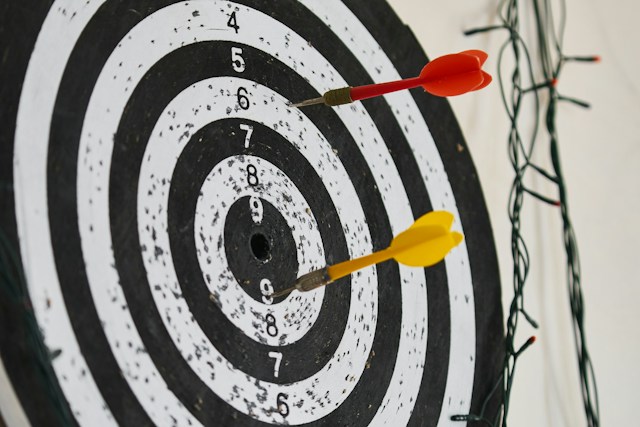Marketing goals are broad, overarching targets that align with the company’s overall business goals. They reflect what the business wants to achieve through its marketing activities in the long term. These goals are typically qualitative and set the general direction for marketing efforts. Examples of marketing goals include:
1st Goal: Increasing brand awareness
Increasing brand awareness is a common marketing goal that involves making more potential customers aware of a brand, its products, or its services. This goal is fundamental for businesses looking to expand their market presence, attract new customers, and establish a solid brand identity. Here’s an elaboration on what increasing brand awareness entails in the context of marketing goals:
Definition and Importance
- Brand Awareness: Refers to the extent to which consumers are familiar with the qualities or image of a particular brand’s goods or services. High brand awareness means consumers easily recognize and recall the brand.
- Importance: Brand awareness is crucial as it’s often the first step in the marketing funnel. Before consumers can consider purchasing, they need to know a brand exists. Increased awareness can increase market share, customer loyalty, and competitive advantage.
Strategies to Increase Brand Awareness
- Content Marketing: Creating and distributing valuable, relevant, consistent content to attract and retain a clearly defined audience. This can include blog posts, videos, podcasts, and infographics that provide helpful information or entertainment to potential customers. What are Content Marketing Strategies?
- Social Media Marketing: Using social media platforms to connect with your audience to build your brand, increase sales, and drive website traffic. This involves publishing great content, engaging with followers, analyzing results, and running social media advertisements.
- Search Engine Optimization (SEO): Optimizing your website and content to rank higher in search engine results pages making it easier for potential customers to find your brand when searching for related topics or products.
- Influencer Partnerships: Collaborating with influencers with a significant following in your target market to promote your brand. This can lend credibility to your brand and introduce it to potential customers authentically.
- PR and Media Coverage: Gaining coverage in media outlets can introduce your brand to a broader audience. This can be achieved through press releases, events, or media partnerships.
- Sponsorships and Community Events: Sponsoring events, teams, or community initiatives can increase brand visibility among specific audiences and create positive associations with your brand.
Measuring Brand Awareness
Increasing brand awareness is a goal that must be measured to understand its effectiveness. Metrics to measure brand awareness include:
- Brand Recall and Recognition: Surveys and studies to determine how easily people can recall or recognize your brand.
- Website Traffic: The number of visitors to your brand’s website, indicating interest in your brand.
- Social Media Metrics: Such as followers, likes, shares, and mentions, which can indicate how widely your brand is being discussed and recognized.
- Search Volume: The number of searches for your brand on search engines indicates how often people are looking for your brand.
Increasing brand awareness is a foundational goal in marketing that supports other objectives like lead generation, sales, and customer loyalty. By making more people aware of the brand, businesses can create a more extensive potential customer base and pave the way for long-term growth and success.
Brand Awareness: Building | Improving | Measuring
2nd Goal: Enhancing brand reputation and image
Enhancing brand reputation and image is a crucial marketing goal that focuses on improving how a brand is perceived by its target audience and the general public. A positive brand reputation and strong brand image can increase trust, customer loyalty, and competitive advantage, ultimately impacting a business’s bottom line. Here’s a detailed look at what this goal involves:
Understanding Brand Reputation and Image
- Brand Reputation: Refers to the collective perceptions and attitudes of consumers and the public towards a brand based on their experiences and interactions with the brand and the information available about it. It’s about how trustworthy, reliable, and credible a brand is perceived.
- Brand Image: Involves the beliefs, ideas, and impressions people hold about a brand. It’s more about consumers’ emotional and psychological associations with the brand, such as luxury, innovation, or sustainability.
Strategies to Enhance Brand Reputation and Image
- Quality Products and Services: Ensuring high-quality offerings is fundamental. Consistently meeting or exceeding customer expectations can positively impact your brand’s reputation and image.
- Customer Service Excellence: Providing outstanding customer service, especially in resolving issues, can significantly enhance a brand’s reputation. Positive customer service experiences lead to word-of-mouth referrals and increased trust.
- Transparent Communication: Being open and honest in all business practices and communications builds trust. This includes acknowledging mistakes and being transparent about products, services, and corporate policies.
- Corporate Social Responsibility (CSR): Engaging in socially responsible initiatives, such as environmental sustainability, community involvement, and ethical business practices, can improve the brand’s image and appeal to socially conscious consumers.
- Content Marketing: Creating content that reflects the brand’s values and mission can shape its image. Educational, inspirational, and value-driven content can position the brand positively in the minds of consumers.
- Online Reputation Management: Actively monitor and manage the brand’s online presence, including responding to reviews, engaging with customers on social media, and addressing negative feedback promptly and professionally.
- Influencer and Brand Advocacy: Collaborating with influencers who align with the brand’s values and nurturing brand advocates among satisfied customers can amplify positive messages and improve brand image. Brand Advocacy: Meaning | Types | Examples
Measuring the Enhancement of Brand Reputation and Image
To gauge the success of efforts to enhance brand reputation and image, businesses can use several metrics and methods, such as:
- Customer Satisfaction and Loyalty Surveys: Regular surveys can provide insights into how customers perceive the brand and their level of satisfaction and loyalty.
- Net Promoter Score (NPS): This metric assesses the likelihood of customers recommending the brand to others, a strong indicator of brand reputation.
- Social Media Sentiment Analysis: Analyzing the tone and sentiment of social media mentions and conversations can give an idea of the brand’s public perception.
- Brand Health Tracking: Regularly monitoring key brand health metrics, such as brand awareness, brand equity, and customer perceptions, to track changes over time.
Enhancing brand reputation and image is a long-term goal that requires consistent effort and alignment across all aspects of the business, from product development and customer service to marketing and corporate governance. A strong brand reputation and positive image can lead to greater customer loyalty, attract new customers, and provide a competitive edge in the marketplace.
What are brand reputation strategies?
3rd Goal: Entering new markets or segments
Entering new markets or segments is a strategic marketing goal that involves expanding a business’s reach by introducing its products or services to new geographical areas, demographics, or customer segments. This goal is pivotal for businesses looking to grow, diversify their customer base, and increase revenue. It requires careful planning, market research, and tailored marketing strategies to ensure successful entry and sustainable growth in the new market. Here’s a detailed look at what this goal entails:
Understanding Market Entry
- New Geographical Markets: This could involve expanding locally (e.g., to a new city or region within the same country) or internationally. International expansion presents additional challenges, such as cultural differences, regulatory environments, and logistical complexities.
- New Customer Segments: Targeting new demographic groups (e.g., age, gender, income level) or customer types (e.g., businesses vs. consumers) that were not previously the focus of the company’s marketing efforts.
- New Product Categories: Introducing existing products to markets where they haven’t been offered before, or developing new products tailored to the needs and preferences of the new market.
Strategies for Entering New Markets or Segments
- Market Research: Conducting thorough market research to understand the new market’s size, competition, customer needs, cultural nuances, and regulatory environment is critical for informed decision-making.
- Localization: Adapting marketing messages, product offerings, and customer service to meet the cultural and linguistic preferences of the new market. Localization goes beyond translation, encompassing a deep understanding and respect for local customs and behaviors.
- Strategic Partnerships and Alliances: Partnerships with local businesses can provide valuable insights and access to established distribution channels and customer bases.
- Pilot Programs and Testing: Launching small-scale pilot programs or market tests can provide valuable feedback and insights, allowing adjustments before a full-scale rollout.
- Tailored Marketing Strategies: Developing marketing strategies and campaigns that resonate with the new market’s audience. This could involve different channels, messaging, and value propositions based on the market’s unique characteristics.
- Compliance and Regulatory Considerations: Ensuring all products, services, and marketing practices comply with local laws and regulations, including data protection, consumer rights, and industry-specific standards.
Measuring Success in New Markets or Segments
To evaluate the effectiveness of the market entry strategies, businesses can use several metrics, such as:
- Market Share: The percentage of sales in the new market relative to the total sales volume of all competitors.
- Sales Growth: The increase in sales revenue from the new market over a specified period.
- Customer Acquisition Cost (CAC): The cost associated with acquiring a new customer in the new market can be compared against the customer’s lifetime value (LTV) to assess profitability.
- Customer Feedback and Satisfaction: Direct feedback and satisfaction levels from new customers can provide insights into how well the product or service meets the new market’s needs.
- Brand Awareness: The brand recognition and recall level among the target audience in the new market.
Entering new markets or segments is a complex process that requires a deep understanding of the new target audience, a clear value proposition, and a commitment to adapting and responding to new challenges and opportunities. Successful market entry can lead to significant growth opportunities and a more diversified and resilient business.
Ansoff Product Market Expansion Grid
4th Goal: Building customer loyalty and engagement
Building customer loyalty and engagement is a critical marketing goal that creates strong, lasting customer relationships. This goal aims to turn one-time buyers into repeat customers and brand advocates. Achieving this requires delivering consistent value, exceptional customer experiences, and engaging customers meaningfully. Here’s a detailed exploration of what this goal involves:
Understanding Customer Loyalty and Engagement
- Customer Loyalty: Refers to customers’ willingness to repeatedly return to a company to conduct some business due to the delightful experiences and value they receive. Loyal customers often spend more, are less price-sensitive, and are likely to recommend the brand to others.
- Customer Engagement: Involves the interactions between the customer and the brand across various touchpoints. High engagement means that customers are passive buyers and actively interact with the brand through social media, forums, events, and feedback mechanisms.
Strategies for Building Customer Loyalty and Engagement
- Exceptional Customer Service: Providing prompt, helpful, and empathetic customer service at every touchpoint. This includes after-sales support, handling complaints gracefully, and going above and beyond to meet customer needs.
- Personalization: Tailoring interactions, communications, and offerings to meet individual customer preferences and needs. Personalization can significantly enhance the customer experience, making them feel valued and understood.
- Quality and Value: Consistently delivering high-quality products or services that offer real value to customers. This builds trust and satisfaction, which are the foundations of loyalty.
- Loyalty Programs: Implementing loyalty or rewards programs that provide tangible benefits to repeat customers, such as discounts, exclusive offers, or points redeemable for products or services.
- Customer Engagement Initiatives: Creating opportunities for customers to engage with the brand beyond transactions. This can include social media interactions, user-generated content campaigns, community forums, events, and workshops.
- Feedback and Continuous Improvement: Actively seeking customer feedback through surveys, reviews, and direct communication and using this feedback to improve products, services, and customer experiences continuously.
- Consistent Communication: Keeping customers informed and engaged through regular, relevant communication across various channels (e.g., email newsletters, social media updates, blogs) while avoiding overcommunication or spam.
Measuring Customer Loyalty and Engagement
To gauge the effectiveness of efforts to build loyalty and engagement, businesses can use several metrics and methods, such as:
- Net Promoter Score (NPS): Measures the likelihood of customers recommending the brand to others, providing insights into customer loyalty.
- Repeat Purchase Rate: The percentage of customers who make more than one purchase over a specific period, indicating loyalty.
- Customer Lifetime Value (CLTV): The total value a customer is expected to bring to the business over their lifetime. Higher CLTV indicates higher loyalty.
- Engagement Metrics: Includes social media likes, shares, comments, website visit duration, and interaction rates with emails and other communications.
- Customer Satisfaction Scores (CSAT): Measures customers’ satisfaction with a company’s products or services, which can correlate with loyalty.
Building customer loyalty and engagement is an ongoing process that requires consistent effort and a customer-centric approach. Businesses can cultivate a loyal customer base that drives sustainable growth and success by focusing on delivering value, fostering positive experiences, and engaging customers in meaningful ways.
Customer loyalty: Meaning | Programs | Examples











